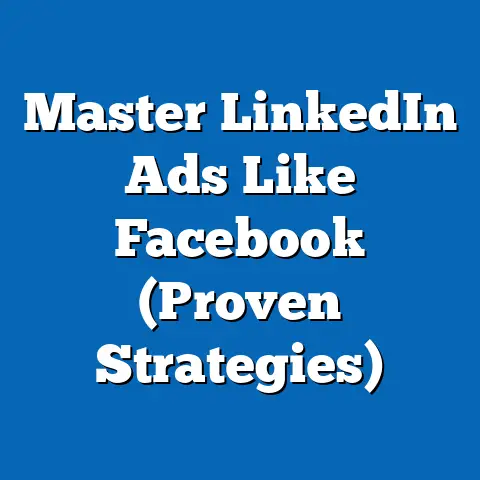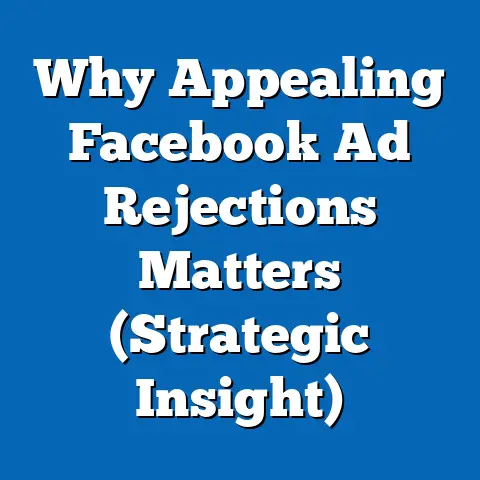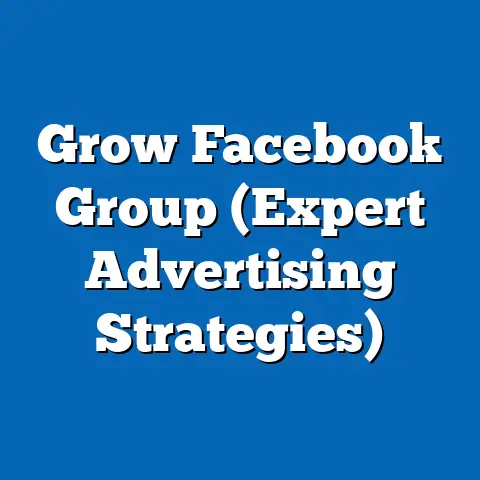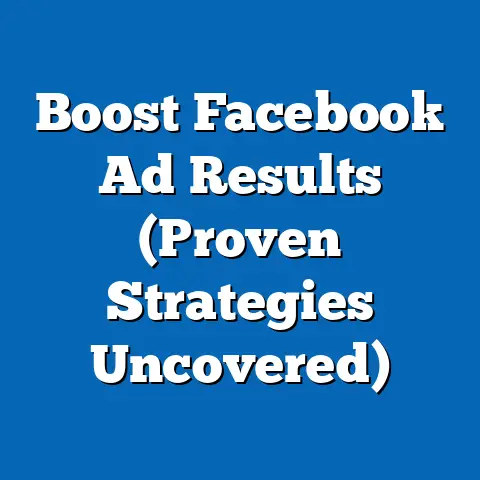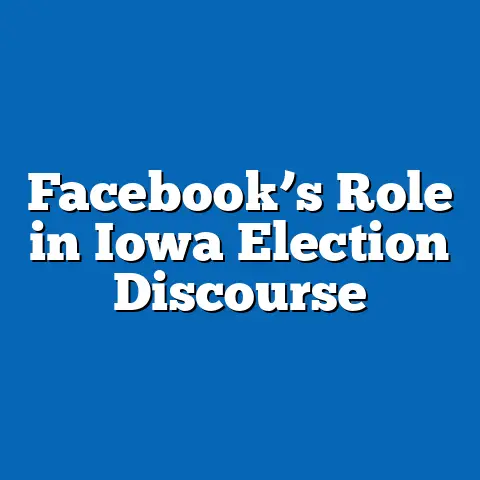Master Facebook Ads with Plastiq (Unlock Powerful Strategies)
In the fast-paced world of digital marketing, first impressions are everything. With over 2.9 billion monthly active users as of Q2 2023, according to Meta’s official reports, Facebook remains one of the most powerful platforms for advertisers to reach diverse audiences. For businesses leveraging tools like Plastiq—a payment platform that allows users to pay bills and vendors with credit cards even when cards aren’t accepted—pairing its financial flexibility with Facebook Ads can create a game-changing strategy.
The importance of first impressions in advertising cannot be overstated. Studies by the Nielsen Norman Group indicate that users form opinions about a website or ad within the first 0.05 seconds of viewing it. When applied to Facebook Ads, this means that visuals, messaging, and targeting must be meticulously crafted to capture attention instantly.
This article dives deep into mastering Facebook Ads with the strategic use of Plastiq, exploring key statistics, demographic trends, and actionable strategies. We’ll break down how businesses can optimize their ad campaigns, leverage Plastiq for financial efficiency, and ultimately unlock powerful growth opportunities. Whether you’re a small business owner or a seasoned marketer, these insights will help you navigate the ever-evolving digital advertising landscape.
Section 1: The State of Facebook Advertising in 2023
Unpacking the Numbers: Scale and Reach
Facebook Ads continue to dominate the digital advertising space due to their unparalleled reach and targeting capabilities. As of 2023, Meta reports that Facebook’s advertising platform reaches approximately 2.1 billion people daily, accounting for nearly 27% of the global population. Moreover, businesses spent over $131 billion on Facebook Ads in 2022, a figure projected to grow by 8.4% in 2023, according to eMarketer.
The platform’s ability to deliver personalized ads is a key driver of its success. With 98% of its revenue derived from advertising, as per Meta’s 2022 Annual Report, Facebook has invested heavily in machine learning and data analytics to refine ad delivery. This results in a click-through rate (CTR) averaging 0.9% across industries, though sectors like finance and retail often see higher rates of 1.2–1.5%, per WordStream’s 2023 benchmarks.
Historical Trends: Growth and Evolution
Comparing current data to historical trends reveals Facebook’s remarkable growth as an advertising powerhouse. In 2012, the platform generated just $5 billion in ad revenue, a fraction of the $131 billion reported in 2022. This represents a compound annual growth rate (CAGR) of over 38%, showcasing how businesses increasingly rely on the platform for customer acquisition.
Additionally, the average cost-per-click (CPC) has fluctuated over the years due to competition and market saturation. In 2017, the average CPC was $0.35, but by 2023, it has risen to $0.97, according to Statista. This increase reflects the growing demand for ad space, particularly in competitive industries like e-commerce and technology.
Demographic Insights: Who’s Engaging?
Understanding the demographic breakdown of Facebook’s user base is critical for effective ad targeting. As of 2023, data from Statista shows that 25–34-year-olds make up the largest user group at 31.5%, followed by 18–24-year-olds at 23.4%. Gender distribution is nearly even, with 56.3% male users and 43.7% female users globally.
Geographically, the platform’s reach is strongest in Asia-Pacific, with over 1.2 billion users, followed by Europe (413 million) and North America (266 million). For businesses using Plastiq to manage cash flow or vendor payments, targeting these demographics—especially small business owners aged 25–44 in urban markets—can yield significant returns. These users are often decision-makers seeking financial tools and services to streamline operations.
Section 2: Why Plastiq and Facebook Ads Are a Winning Combination
What Is Plastiq?
Plastiq is a payment platform designed to help businesses and individuals pay bills and vendors using credit cards, even when cards are not directly accepted. Launched in 2012, Plastiq has facilitated over $10 billion in payments as of 2023, according to company announcements. It charges a small fee (typically 2.9% per transaction) for the convenience, but the ability to earn credit card rewards and manage cash flow makes it a valuable tool for small businesses.
For advertisers, Plastiq offers a unique advantage: the ability to fund marketing campaigns, including Facebook Ads, through credit cards. This flexibility can be a lifeline for businesses with tight cash flow, allowing them to invest in growth while deferring immediate payment.
Aligning Financial Flexibility with Ad Spend
Digital advertising often requires upfront investment, and Facebook Ads are no exception. The average small business spends between $500 and $3,000 per month on Facebook Ads, per Hootsuite’s 2023 Digital Marketing Report. For many, this represents a significant portion of their marketing budget, making tools like Plastiq indispensable.
By using Plastiq to pay for ad spend via credit card, businesses can take advantage of rewards programs—some cards offer 1–2% cashback or points on business purchases, effectively offsetting Plastiq’s fee. Additionally, deferring payment to the next billing cycle can provide breathing room to assess campaign performance before settling the balance.
Case Study: Small Business Success
Consider the example of a small e-commerce retailer specializing in eco-friendly products. In 2022, they used Plastiq to fund a $2,000 Facebook Ads campaign targeting eco-conscious consumers aged 25–44. According to their internal data shared in a Plastiq case study, the campaign generated a return on ad spend (ROAS) of 4.5x, translating to $9,000 in sales.
This success highlights how combining Plastiq’s payment flexibility with precise Facebook Ads targeting can drive measurable results. The retailer also earned 1.5% cashback on their credit card, reducing the net cost of using Plastiq to just 1.4% of the transaction.
Section 3: Crafting High-Impact Facebook Ads
The Importance of First Impressions in Ad Design
As mentioned earlier, users form opinions about ads in milliseconds. A 2021 study by HubSpot found that 55% of viewers stop watching video ads within the first two seconds if they’re not engaging. For static ads, bold visuals and concise copy are non-negotiable to stand out in a crowded News Feed.
Key elements of a successful ad include a striking image or video, a clear value proposition, and a strong call-to-action (CTA). For instance, ads with CTAs like “Shop Now” or “Learn More” see 2.5x higher CTRs compared to generic messaging, per Facebook’s own 2022 ad performance data.
Targeting the Right Audience
Facebook’s ad platform offers granular targeting options, from demographics and interests to behaviors and lookalike audiences. A 2023 report by Social Media Examiner found that 72% of marketers consider audience targeting the most valuable feature of Facebook Ads. For Plastiq users, focusing on small business owners or entrepreneurs in specific industries (e.g., retail, consulting) can maximize relevance.
Lookalike audiences, which allow advertisers to target users similar to their existing customers, have proven particularly effective. Businesses using lookalike audiences report a 30% lower cost-per-acquisition (CPA) compared to broader targeting, according to a 2022 study by AdEspresso.
Budgeting and Bidding Strategies
Effective budgeting is critical to mastering Facebook Ads. The platform operates on a bidding system, where advertisers compete for ad placements based on budget and relevance. Data from WordStream shows that the average cost-per-thousand-impressions (CPM) in 2023 is $7.19, though this varies widely by industry and audience.
For Plastiq users, starting with a modest daily budget of $20–50 can help test different ad creatives and audiences without overspending. Once high-performing ads are identified, scaling the budget while using Plastiq to manage cash flow ensures sustained momentum without financial strain.
Visualization Description: Ad Performance Dashboard
Imagine a dashboard tracking key metrics for a Facebook Ads campaign funded through Plastiq. The interface displays a line graph showing daily ad spend ($50–$200) alongside ROAS (ranging from 2x to 5x over a 30-day period). A pie chart breaks down audience demographics, with 60% aged 25–34 and 40% aged 35–44, while a bar chart compares CTRs across ad creatives (e.g., video ads at 1.8% vs. static ads at 0.7%). This visual representation helps advertisers quickly identify trends and optimize their strategy.
Section 4: Advanced Strategies for Maximizing ROI
Retargeting for Higher Conversions
Retargeting, or remarketing, allows businesses to re-engage users who have interacted with their brand but didn’t convert. According to a 2023 report by Criteo, retargeted ads have a 70% higher conversion rate compared to initial ads. For Plastiq users promoting financial services, retargeting website visitors or past customers with tailored offers (e.g., “Save on Your Next Payment”) can drive significant results.
Implementing the Facebook Pixel—a tracking code for website activity—is essential for effective retargeting. Data from Meta indicates that advertisers using the Pixel see a 25% increase in ad relevance scores, leading to lower CPCs and higher engagement.
A/B Testing for Optimization
A/B testing, or split testing, involves running multiple versions of an ad to determine which performs best. A 2022 study by Optimizely found that 58% of marketers who regularly A/B test their Facebook Ads report improved ROAS. Variables to test include headlines, images, CTAs, and audience segments.
For example, a Plastiq-powered campaign might test two ad creatives: one highlighting “Pay Vendors with Credit Cards” and another emphasizing “Earn Rewards on Every Payment.” After a week, the ad with a 1.5% CTR outperforms the other at 0.8%, guiding future budget allocation.
Leveraging Video Ads
Video content continues to dominate social media engagement. Facebook reports that video ads account for 50% of total ad impressions in 2023, with users spending 3x longer watching videos compared to static content. Short, impactful videos (15–30 seconds) with captions—since 85% of videos are watched on mute, per Digiday—can significantly boost engagement.
Businesses using Plastiq to fund video ad campaigns can showcase customer testimonials or quick tutorials on financial management. These formats resonate with audiences, often achieving 20–30% higher completion rates, according to Meta’s 2023 ad insights.
Section 5: Demographic Patterns and Tailored Messaging
Age and Gender Differences
Demographic data reveals distinct patterns in how different groups engage with Facebook Ads. For instance, users aged 18–24 are more likely to engage with trendy, visually driven content, with a 2.1% average CTR, per WordStream. In contrast, users aged 35–44 prioritize value-driven messaging, such as discounts or practical solutions, with a slightly lower CTR of 1.3%.
Gender also plays a role. Women are 15% more likely to click on ads related to lifestyle and personal finance, while men show higher engagement with tech and business services, according to a 2022 report by Sprout Social. For Plastiq campaigns, tailoring messaging—e.g., emphasizing rewards for women and efficiency for men—can enhance relevance.
Geographic and Cultural Considerations
Geographic targeting allows advertisers to customize campaigns based on location-specific needs. In North America, where Plastiq is widely used, focusing on urban centers with high concentrations of small businesses can yield better results. Data from the U.S. Small Business Administration shows that 99.9% of U.S. businesses are small businesses, with many clustered in cities like New York and Los Angeles.
Cultural nuances also matter. In Asia-Pacific markets, where mobile usage dominates (over 90% of Facebook users access the platform via mobile, per Statista), ads must be optimized for smaller screens with quick-loading visuals. Tailoring campaigns to local languages and customs can further boost engagement by 25%, according to a 2023 Nielsen study.
Section 6: Challenges and Pitfalls to Avoid
Rising Ad Costs and Competition
As Facebook Ads become more popular, costs are rising. The average CPC increased by 17% from 2022 to 2023, per Statista, making it harder for small businesses to compete with larger players. Using Plastiq to strategically manage ad spend can help mitigate this, but careful budget planning remains essential.
Ad Fatigue and Audience Overlap
Ad fatigue—when users see the same ad too often—can lead to declining performance. A 2022 study by Kantar found that 68% of users ignore ads they’ve seen repeatedly. Rotating creatives every 7–14 days and capping frequency (e.g., limiting impressions to 2–3 per user per week) can prevent this issue.
Audience overlap, where multiple campaigns target the same users, is another concern. Facebook’s Audience Insights tool can help identify overlap, with data showing that reducing overlap by 20% can lower CPA by up to 15%, per a 2023 AdEspresso report.
Section 7: Broader Implications and Future Trends
The Role of AI in Ad Optimization
Artificial intelligence (AI) is transforming Facebook Ads, with Meta’s Advantage+ suite automating campaign creation and optimization. Early adopters report a 20% reduction in CPA using AI-driven tools, according to a 2023 Meta blog post. For Plastiq users, integrating AI recommendations with financial flexibility can unlock even greater efficiency.
Privacy Regulations and Data Shifts
Privacy changes, such as Apple’s iOS 14.5 update in 2021, have impacted ad tracking, with Meta estimating a $10 billion revenue loss in 2022 due to reduced targeting accuracy. Advertisers must adapt by focusing on first-party data (e.g., email lists) and contextual targeting, trends likely to intensify through 2025.
The Bigger Picture
Mastering Facebook Ads with Plastiq is more than a tactical move; it’s a strategic approach to sustainable growth. By combining precise targeting, creative excellence, and financial tools like Plastiq, businesses can navigate rising costs and privacy challenges while maximizing ROI. As digital advertising evolves, those who adapt to data-driven strategies and leverage innovative payment solutions will stay ahead of the curve.
The synergy of Facebook Ads and Plastiq offers a blueprint for small businesses and marketers alike. With the right mindset and tools, the potential for growth is limitless—whether reaching new customers, optimizing cash flow, or scaling campaigns. The future of advertising lies in adaptability, and this powerful combination is a step toward mastering it.

